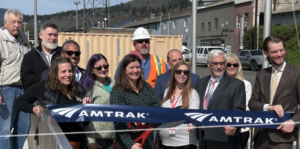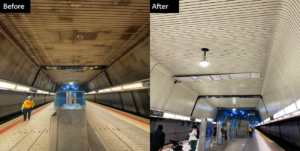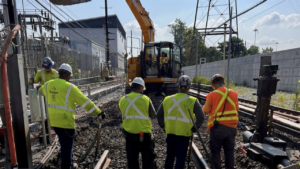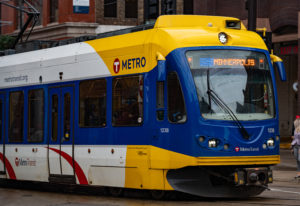Keeping things moving quickly
Written by Jenifer Nunez, assistant editor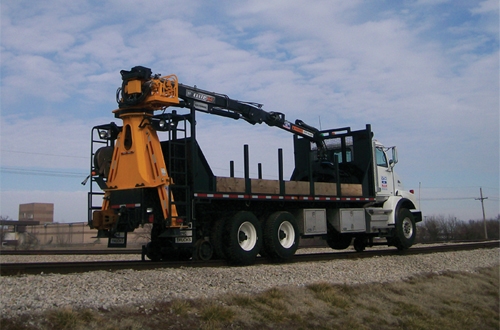
Trackwork requires materials to be moved to the right place at the right time, advances to material handling equipment is helping make that happen.
Railroaders know that the way material is handled is just as important as the materials themselves, which is why they have been investing in the latest technology and machinery suppliers are offering this year.
Brandt
Brandt Road Rail Corporation uses its OTM Tracker system in an aggregate material handling application.
“This application works very well with the OTM Tracker as it uses the aggregate cars as its platform to safely walk and unload the material,” said Neil Marcotte, sales and marketing manager. “We can size the bucket to maximize its unloading time, making big jobs seam little.”
It unloads material such as ballast, coal, iron ore and other types of aggregate material. Because the OTM Tracker is used in combination with a Brandt Power Unit, it makes the material handling package mobile, allowing it to get to the worksites quickly to load or unload material.
“Because the OTM Tracker always has at least four positively-locked clamps on the railcars at all times (eight clamps while working) it makes it a very safe alternative for railways to handle material,” noted Marcotte.
Dymax
In 2011, Dymax developed another Ballast Blaster undercutter specifically for smaller machines. Originally offered for the eight-ton hex, this six-foot bar can get in and work around switches or tight multiple track areas. The undercutter is also suitable for spot undercutting jobs of five, 10 and15 feet.
“Don’t let the size fool you, it cuts like all the other Dymax Ballast Blasters,” noted Scott Balderson, vice president of sales.
Features include 360-degree rotation, double-tipped carbide teeth for cutting in both directions, chromium carbide wear plates and a hydraulic motor that matches with the machine, meaning no extra power source. This unit has just been launched for backhoe loaders, as well.
Dymax released its two-motor tamper for small hex and backhoe loaders. This unit features 360-degree rotation and a shorter profile, which Dymax says gives the operator a significant off-track working area because of the increased lifting of the shorter unit.
The Dymax Rail Rider was released at the most recent REMSA show. It allows the Backhoe Loader to become a high-rail system machine for both the front and back of the machine. All done in 60 seconds or less and no hydraulics needed.
“Dymax is the true innovator of rail work tools,” explained Balderson.
Georgetown
Georgetown Rail Equipment Company recently unveiled a new ballast delivery system and complementing service, dubbed BallastSaver, which is an upgrade to its predecessor, GateSync.
With input from current customers, GREX enhanced its current fleet of equipment with goals to provide an even safer work environment while increasing production.
“Safety is priority number one at GREX, as we constantly work with customers to ensure that we are providing not only the most productive equipment but more importantly, the safest,” explained Lynn Tuner, vice president of marketing and sales.
BallastSaver utilizes cutting-edge technology to provide an accurate and efficient mode of ballast delivery for maintaining the optimum ballast profile.
“With BallastSaver there is no need for the unsafe and less-productive practice of personnel walking beside the ballast cars to manually operate the gates. BallastSaver determines the correct amount of rock needed through an automated survey process to determine the ballast requirements and then operates the gates, ensuring precision delivery, thus achieving the customer’s desired profile,” Turner noted.
GREX has also enhanced their Self Powered Slot (SPS) units with the addition of zero-turn-radius excavators to allow the SPS to work safely on one track of double mainline territory without the possibility of fouling the adjacent track.
As a result of its constant focus on safety, 2012 marked the fourth consecutive year that GREX earned the Gold Level NRC Contractor Safety Award. All GREX personnel are safety certified annually and attend equipment-specific safety training. GREX safety officers conduct both scheduled and unscheduled safety audits on employees, vehicles and equipment.
Herzog Railroad Services
Track and time, or lack thereof, is a discussion point when meeting with railroad engineering personnel, notes Tim Francis, vice president of marketing at Herzog Railroad Services, Inc.
“At Herzog we are never satisfied and complacency is not an option,” Francis stated. “In 2005, we introduced the R.U.M. (Rail Unloading Machine) to the railroad industry. The R.U.M. was designed to help streamline the process for rail unloading by making it safer, faster and more cost-effective. With the R.U.M. there is no need to tie off the rail when unloading and there is no longer a need for a winch car.”
The R.U.M. meets the train at the unloading site, ties itself onto the train and starts unloading rail. The R.U.M. is a completely self-contained unit that can travel on the rail or the highway under its own power. It has the capability of unloading an entire 40-pocket train in less than six hours with a crew of two and can unload either single or double rails simultaneously.
“At Herzog, we are always looking to improve every product offering with our name on it,” Francis noted. “The most recent upgrade to the R.U.M. was to our power boxes.”
The power boxes are the muscle used to pull the rail off of the rail train and Herzog has just finished a major capital upgrade to modify them from a two-wheel drive (three roller system) to a four-wheel drive (four roller system).
“This upgrade allows us to more efficiently pull rail from the train,” he said. “The four-wheel drive system has two rollers on top of the rail and two on the bottom that are pulling the rail. This incremental increase in unloading efficiency can be vital in this time of increased train traffic and shrinking work windows. Every second counts.”
Loram
“Loram’s Raptor Rail Handling System leads the industry in speed, performance, reliability and safety,” stated Joe Ashley, manager of marketing and business development for Loram Maintenance of Way, Inc. “This revolutionary technology outperforms traditional rail handling systems and provides a better solution for the entire process of rail relay, where other systems are focused only on rail delivery.”
The North American rail train fleet is utilizing old technologies that have become obsolete and are nearing the end of their useful life, notes Ashley. He says the replacement of traditional trains is inevitable and requires a large capital investment.
“This fleet obsolescence provides for an opportunity of refreshing the fleet with new technology that provides improved efficiencies,” he stated.
Loram’s Rail Handling system has a productivity of 3,000 feet per hour and provides a product that is relay rail ready. Since the introduction of this product, Loram has experienced zero injuries.
Loram says its Raptor Rail Handling System eliminates the risk of injury through the use of cutting-edge technologies by reducing human interaction with rail.
“One of the key advantages is it retains total control of the rail while loading and unloading,” Ashley explained. “The equipment provides a stable and ergonomic workstation that locks the rail in place mechanically when there is a requirement for people to come into physical contact with the rail.”
Rcrane
“Rcrane has made it possible for railroads to build better bridges and more rapidly replace track with longer/heavier bridge and track panels,” said Paul Markelz, founder of Rcrane, LLC.
“To achieve these new capabilities, Rcrane developed machines to mobilize the safety, strength and stability of dual 40-ton overhead hoists and the railcars and transporters known as Rflats and Rmules to rapidly stage, transport and feed material to and from the two 40-ton overhead hoists in order to combine delivery, installation, demolition and removal of bridge and track material at any work site via a self contained train,” said Markelz.
Each Rcrane is equipped with two sets of Rmules to move old materials out of the work site across Rflats and move new materials over Rflats into Rcrane for installation.
“The key to maximizing the value of Rcrane is to plan projects in detail down to each day’s work tasks and material needs to rapidly deploy and minimize the track window,” Markelz noted.
He says Rcrane is engineered as a stable platform with four corners of support to practically eliminate tipping and a low overall height of 19 feet and 10 inches to work in trusses and tunnels and eliminate boom contact with overhead wires.
“With two hoists operating in sync picking up longer/heavier old and new panels from the on-rail position, those materials experience fewer secondary rigging stresses. By remaining on-track, Rcrane eliminates the planning, permitting and construction of access roads and extensive site preparation for off-track cranes and eliminates the risk of delays due to flooding down below in the waterway during site prep and material staging and delivery,” Markelz said.
RCE
Rail Construction Equipment Company has expanded the capabilities of its 225D High Rail Excavator, which CSX is using on its steel gangs for handling rail in place of cranes.
RCE has increased its presence in the handling of rail material with the RCE 544K swing loader, which offers a high-rail wheel loader platform with a swing front boom assembly and a wide range of material handling front attachments.
“The biggest thing we are seeing is there seems to be a higher demand for equipment by Class 1s and contractors this year and the requests have come earlier than previous years,” noted Dennis Hanke, railroad specialist.
When it comes to safety, RCE is always striving to improve with training and the use of conventional Deere construction equipment as its primary platform.
V&H
V&H Inc., Trucks, has recently introduced an all-new hydrostatic remote drive system that has eliminated the high PTO torque loads often seen with other types of hydrostatic systems, notes Tim Minor, railroad support, Kansas Division.
“Reliability, ease of operation and safety were the primary goals when this system was designed,” he said. “The controls are conveniently located on the right hand joystick with one button each for forward/reverse speeds and a fail safe switch that will shut down the system if the operator’s hand comes off of joystick. With our new system, we were also able to eliminate the hydraulic stall found under heavy load conditions.”
Minor says the market for material handling trucks is in a very strong upward trend right now but pricing continues to be a concern, even though the demand is high. Request for quick delivery times have continued for V&H, as they have over the past few years.
“When the customer calls needing a material handler they usually have a job waiting for the equipment,” he explained. “We have been able to drastically shorten lead times on new orders by stocking all of the components needed to assemble multiple units. Buying in quantity has also maximized our purchasing power and allowed us to pass the savings on to the customer.”
V&H offers a variety of training courses that are geared toward maintenance and safety. With its new webcasting facility, the classroom is brought to the customer at their convenience through the web.
Vaia Car
Vaia Car recently acquired Sorema, an Italian company with more than 30 years experience in manufacturing railway maintenance-of-way products. Among its many products is the PS 2003 S 600 Ballast Handler.
“This machine brings a new dimension to distributing, regulating and moving ballast on the railway lines,” noted Cal Coy, consultant.
This 700 hp-70-ton machine can pull ballast cars to dump ballast, regulate and dress ballast, load material in a self-contained 12-cubic-yard hopper or load into special hopper cars. Equipped with a 40-inch diameter ballast broom and loading conveyor, two bi-directional center plows and two articulated bi-directional side wings, the S 600 can handle every ballast condition, explains Coy.
“With a travel speed of 60 mph and a regulating speed of up to 10 mph, this 60-foot long giant can make short work of any project,” he said.
The braking system provides air for cars being towed, as well for the basic unit. A 500-gallon water tank is available so the ballast can be sprayed to reduce dust when required. Work and travel lights are standard, which means work can be conducted any time of the day. Lastly, a soundproof, air-conditioned, heated cab is said to provide operator visibility and comfort.
“Developed to meet the demand by railway engineers for higher travel speeds, more productive work cycles, safe operation and operator comfort, the PS 2003 S 600 is currently in service on several railways of the world,” noted Coy.


